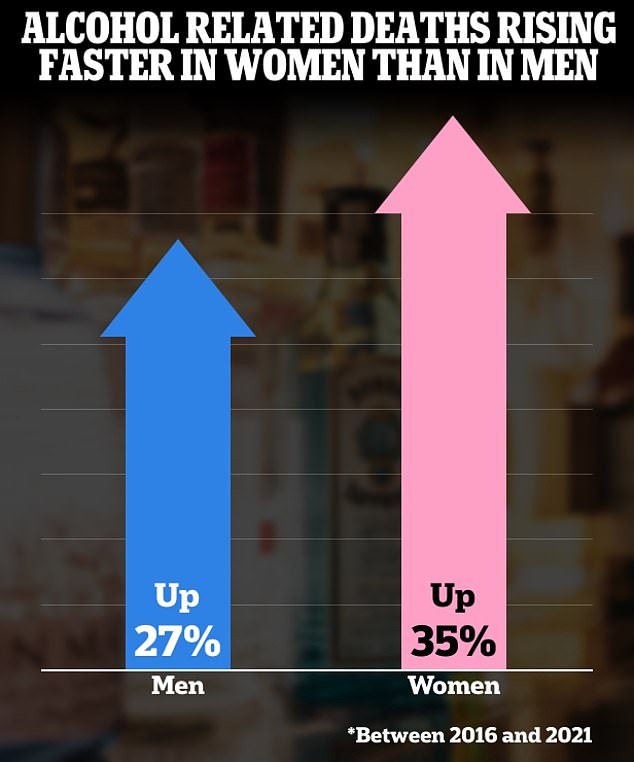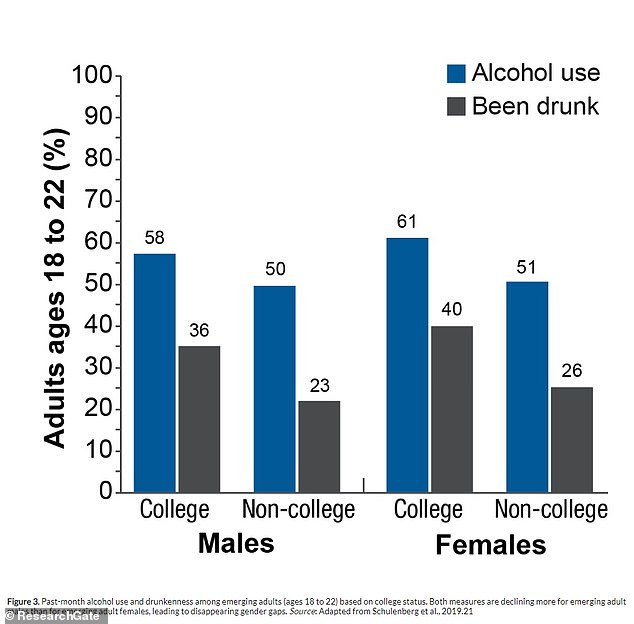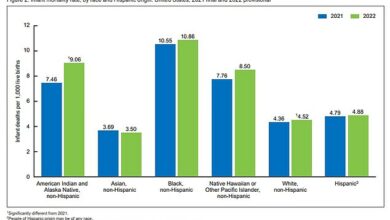How alcohol is much more likely to cause cancer and other health problems in women than in men





For the first time ever, the number of women who drink too much has equalled the number of men. In addition, alcohol-related deaths are rising faster among women than among men.
Although many women pride themselves on their alcohol tolerance, they are increasingly drinking themselves sick.
According to Dr. Sherry McKee, a professor of psychiatry at Yale, rates of alcohol abuse are typically much higher among men, but over the decades they have converged “and the rates are getting closer to one-to-one.”
The growing number of women binge drinking is having devastating consequences, with the number of women dying from alcohol use increasing almost 30 percent faster than the number of men.
Men still die more often than women when it comes to alcohol-related deaths: around 120,000 men and 59,000 women. However, alcohol has a much greater impact on women’s health, including a higher risk of brain damage and cancer.

Alcohol suppresses another chemical in the brain, glutamate, which is responsible for brain activity and energy levels, leading to a slowing of thoughts and feelings.

The number of alcohol-related deaths is increasing in both women and men, but the number is increasing faster in women
Women appear to drink more often than men. An analysis of six different studies between 2000 and 2016 concluded that the number of women aged 18 and over who drink each year grew by six percent but in men it fell by 0.2 percent.
The number of women who binge drink increased by 14 percent, but for men this was only 0.5 percent.
Women have more fatty tissue than men. Alcohol cannot dissolve in this fatty tissue, which means that the toxins remain in their bloodstream for longer. This gives alcohol ample time to destroy the body, damage the brain and destroy the heart and blood vessels.
Despite the now-debunked claim that a glass of red wine with dinner is good for the heart, it is now argued that no amount of alcohol is safe.
Women are advised to drink no more than seven drinks per week, one per day, while men can drink 14 drinks per week, or two or fewer drinks per day.
Exceeding these guidelines and drinking excessively can cause brain damage in women more quickly than in men. However, the true extent of the damage and how quickly it occurs is still being investigated.
Dr McKee said: ‘Women are more vulnerable to the neurotoxic effects of alcohol, so [that means] more neurodegeneration.
“We think there is a general inflammatory process that occurs more often in women than in men as a result of alcohol consumption. This is partly one of the reasons why women are more susceptible or have greater health risks from alcohol consumption.”
Neurotoxic effects can cause a range of symptoms, from reduced brain volume and brain shrinkage, brain cell deathnerve fiber rupture and inflammatory stress.
Alcohol activates the immune system in the brain and a specific type of receptor that detects harmful invaders such as bacteria and viruses and alerts the body.
But chronic drinking can make this receptor more sensitive than normal and keep it on high alert. This can lead to an exaggerated immune response that can be harmful to the body and worsen inflammation.

Although men still outperform women on most alcohol-related measures, the gaps are narrowing
A 2013 experiment showed this in mice. Chronic alcohol exposure caused inflammation, cell damage, and brain cell loss in both male and female mice, but the effects were more pronounced in female mice.
Researchers found that long-term alcohol use causes brain damage by activating the immune response in brain cells.
Women are generally underrepresented in medical research, leaving many unanswered questions about the specific effects of alcohol on the female body.
One thing researchers know for sure: women have a higher water-to-fat ratio. That is, women tend to have more body fat than men, but a lower percentage of body water.
Alcohol is not soluble in fat, only in water. So men, who have a higher percentage of body water, tend to have less alcohol in their bloodstream than women, even when they drink the same amount.
Dr. Julia Adamian, an internist at NYU Langone Hospital, said, “Three drinks in men and three drinks in women have different effects.
‘Women would therefore have a higher alcohol level in their blood [higher fat] to water ratio. The immediate effect [of drunkenness] will be much faster, and [alcohol] remains in the blood longer.’
Women also produce less of the enzyme alcohol dehydrogenase (ADH), which is released in the liver and breaks down alcohol in the body.

For past month alcohol use and reports of drunkenness among women, both on and off campus, where alcohol use exceeded the levels of their male counterparts
Women who die from long-term alcohol use have a chronic condition, while the majority of men who die from alcohol die from acute causes, such as an accident, Dr. McKee said.
She added: ‘Women are more likely to develop alcohol addiction and are more susceptible to blackouts, liver disease, heart disease, cognitive deficits and certain cancers.’
“In addition, there are greater cognitive deficits. There are greater effects on their cardiovascular system and they have greater increases in certain cancers.”
In addition to the number of alcohol-related deaths, women visit the emergency room more often for alcohol-related problems than men.
Between 2006 and 2014, men generally visited the ED more often for alcohol, although the number of visits grew faster among women than among men during the study period: 5.3 percent annually for women. compared to four percent for men.
This increase is primarily due to a greater increase in ED visits related to chronic alcohol abuse among women, which increased by approximately seven percent annually, compared to 4.5 percent for men.
Alcohol has been shown to damage organs including the brain and nervous system, heart, liver, and pancreas.
Alcohol itself is a toxin that causes cell damage and inflammation during metabolism.
It can increase blood pressure and contribute to the development of heart disease, it disrupts the body’s absorption of nutrients and suppresses the immune system.
Compared to women who do not have a history of binge drinking, those who do have about 45 percent higher risk heart disease, while moderate drinkers have a 29 percent higher risk.
Drinking more than three drinks a day can also increase your risk of pancreatic and stomach cancer.
Moderate to heavy drinking has been associated with a 1.5 times greater risk of colorectal cancer, a twofold increased risk of liver cancer and a fivefold increased risk of oral cancer.
When the body processes alcohol, it produces acetaldehyde, a toxic substance that can damage DNA and proteins in cells, leading to mutations and the potential growth of cancer cells.
It may also increase estrogen levels in women, which has been linked to a greater risk of developing breast cancer and other hormone-related cancers.




